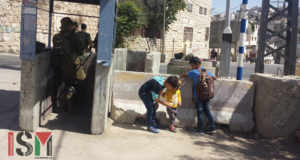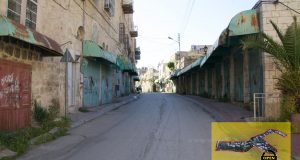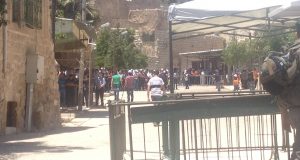1. Home Demolitions in Jabal Shamali a “Mistake”
2. “What did the shops ever do to them?”
3. International Peace Mission receives a frosty reception from Israel
4. IOF Soldiers Kidnap Family
5. Protesters Attacked in Bil’in
6. Freedom Summer 2006
7. Protestors Managed to Remove a Fence in Bethlehem
1. Home Demolitions in Jabal Shamali a “Mistake”
For photos please click here
For Photos from the last incursion into Nablus, please click here
by ISM Nablus
On Saturday the 26th of August, Israeli military invaded the Jabal Shamali area of Nablus and destroyed 22 homes [for a report, pictures and video, see the previous report on the ISM website]. The next day, Israel’s largest newspaper Yedioth Ahronoth reported that the home demolition was “a mistake,” and that the Israeli military failed to arrest two to three Fatah activists that were the target of the operation.
At the end of the incursion, five individual houses and one three-storey block of flats were destroyed. One of the six buildings demolished was a community meeting hall, the others homes belonging to the Saedi, G’name, Sa’eah and Lubaddeh families. Eight cars were also totally wrecked, five of which were dumped onto a neighboring house, causing structural damage in the form of broken base-beams in the roof and the bending of walls.
Additional houses were also damaged during the demolition. The home adjacent to the structure damaged by the demolished cars was severely burn-damaged, and three homes west of the apartment block were 80% destroyed and are now unlivable. In total, 22 homes and apartments were completely demolished, and an additional five homes were made unlivable.
About 100 people were made homeless by the Israeli military’s actions and are now evacuated to friends’ homes in surrounding neighborhoods, or forced to rent apartments around Nablus. With the help of friends and neighbors, they have removed the remains of their homes that were not completely bullet-ridden or shredded by bulldozers and are now planning on rebuilding the homes as they were.
The families have been given $15,000 collectively from the Palestinian government as aid for rebuilding their homes, and friends and neighbors collected an additional $17,000 for the same purpose. This is, however, far from enough money. The cost of rebuilding the Lubaddeh block of flats alone, as estimated by engineers, will amount to about $550,000.
The issue of home demolitions has been discussed at length by the Israeli High Court of Justice in many cases, including Janimat V. IDF Military Commander 1997. In the discussion of this case, published by the Israeli Supreme Court in “Judgments of the Israeli Supreme Court: Fighting Terrorism within in Law”, the Justices argue, “home demolitions are allowed only in light of especially serious terrorist activities, such as involvement in suicide bombings aimed at civilians… The demolitions are subject to legal principals, such as the principle of proportionality. For example, the measure may only be used if it is possible to limit it to the terrorist’s home, without demolishing adjacent dwellings. (60)” In addition, the President of the Court, A. Barak states, “[Demolitions are] implemented in stages and with care in order to prevent damage to the rest of the building. If damage is caused, it will be repaired. (62)” In the case of this incursion, the homes were demolished while searching for suspects, not “in light of especially serious terrorist activities.” In addition, 22 homes were demolished in their attempt to arrest, clearly violating the “principal of proportionality.” According to President Barak, the homes’ of the residents will be repaired, though follow through on this is unlikely.
Nizar Lubbadeh, who gave himself up to be arrested in a desperate bid to stop the demolition of his and his family’s home, was released shortly after questioning. One other man, Mohammad Ayad, was however arrested after the demolition and is still in jail.
According to the Nablus Municipality, 220 buildings have been destroyed in Nablus since the beginning of the current Intifada in September 2000. This number excludes the large number of homes destroyed in Israel’s “Operation Defensive Shield” in 2002.
Following this most recent incursion into Jabal Shamali, the number is now up to 242. This attack marks one of the largest houses to be destroyed. Other big demolitions include a 9-storey building in Rafidya Al-Makhfiyya 3 years ago, belonging to Jafar Maasri who was killed by lethal gas in the Old City, and the Al-Sudder family home in New Askar refugee camp about one and a half years ago.
Amer and Allam Lubbadeh, two brothers made homeless by the demolition, urge anyone who wishes to donate money to the rebuilding of their family home to contact the Palestinian Red Crescent in Nablus, by telephone at 09-2384151, or by fax at 09-2380215.
************************************
2. “What did the shops ever do to them?”
For photos please click here.
by ISM Nablus
This morning between 2 and 4 o’clock Israeli military forces entered Balata Refugee Camp, south-east of Nablus city center. Soldiers traveling in two armoured bulldozers and four military jeeps proceeded to partially destroy of ten shops in the marketplace on the main street of the camp. The bulldozers pulled down whole shop awnings, crushed tiles and cement curbs lining the street, ripped a street sign from the ground, down a wall, cut an electric cable running overhead and destroyed an large arrangement of grape-vines outside a family home.
A local butcher expressed his frustration at the wanton destruction, “They do this because they know that we are all too poor to afford to rebuild our shops. The occupation is strangling our economy”. Pointing at the wrenched-up tiles of the shop porch and the ripped bits of metal sticking out above our heads in place of the bright red and white shop-front that usually greets customers, he continued: “It will take $1,000 just to repair the awning and another $500 for the porch. And I know that many other shop owners have worse damage. But there is no point in repairing any of it because we know that as soon as we fix it, they will come. They will come the next day!”
Despite this, the marketplace was this morning full of men clambering up ladders to tear down the old wrecked shop-fronts and take measurements for new ones. A team of electricians were busy replacing the cut cable and the rubble from the wreckage was neatly piled up at the sides of the street. “What did the shops ever do to them?” one of the workers exclaimed. “They are terrorists? No, this is the terror of the Israeli army.”
This sort of incursion is a regular occurrence in the refugee camps around Nablus, especially Balata. Occupation soldiers invade the camps nightly, though the use of armoured bulldozers is less common. On a ‘normal’ night, soldiers enter the camp around 2am and shoot at residents, occasionally arresting young men or invading and occupying homes. Last night’s incursion and destruction is yet another attack by the Israeli military on the impoverished residents of Palestine’s refugee camps.
*****************************************************
3. International Peace Mission receives a frosty reception from Israel
For photos, please click here.
After a full month of gruelling cycling, the Peace Cycle finally arrived in the West Bank tonight, September 6th. The cyclists left Damascus 3 days ago and toured the Palestinian refugee camps in the south of Syria before entering Jordan. In both Middle East countries, as in Europe, the group enjoyed courteous treatment and a warm welcome.
The climate changed dramatically, however, once they reached the border between Jordan and the Occupied Palestinian West Bank.
The cyclists arrived at the Jordanian side of the “Allenby Bridge” crossing point at 11.30 this morning local time. On the Palestinian side of the border, their coach and tour guide waited for them…and waited. The cyclists, 21 of them British, two Austrian and one Palestinian, were held at the border by the Israeli authorities and were given no information or explanation, although they were eventually given a sandwich.
Some of the Peace Cycle team as they set off from London
The Palestinian man among the group was taken away and questioned for almost 3 hours before he was allowed to enter the West Bank, where he lives with his family in a village near Ramallah. He had taken part in the Peace Cycle so that he could “tell the world about life under occupation” in his country.
At 6pm the border crossing officially closed for the night, with the remaining group of cyclists still being held in no man’s land between Jordan and Palestine, by a frustrated Israeli border staff who admitted they “just wanted to go home”. Eventually, eight hours later, and after frantic ‘phone calls between the Peace Cycle’s London office and the British Consulate in Jerusalem, the cyclists were allowed through to the Palestinian side of the border. Tired and hungry, they were relieved to finally board their coach and look forward to a meal in El Fa’raa in the north of the West Bank, where the villagers had planned a welcome dinner for them.
However, their relief was to be short lived when they encountered first hand experience of military occupation, just outside the village of El Fa’raa. As their hosts awaited them, the cyclists’ coach was stopped at an illegal Israeli checkpoint just minutes away and the group was told it could not proceed. Spurious explanations were given by the soldiers on duty, and despite ‘phone calls to the Israeli authorities from the British Consulate and an Israeli Knesset (Parliament) member, the peace group was held for 3 hours and then told they would not be permitted to cross the checkpoint, indefinitely.
The group had no choice but to divert to Jerusalem where they will spend the night before attempting to restart their tour of the West Bank tomorrow morning.
Whatever the reason behind today’s appalling treatment of the men and women of the Peace Cycle mission, they are more determined than ever to work for an end to the occupation of Palestine as being the only way to a lasting peace for all people of the Middle East.
For more information, contact Laura Abraham, founder of the Peace Cycle, on +44-(0)-794-1056616.
If you would like to arrange phone interviews with the cyclists at any point please contact TPC Press Officer Claire Ranyard (07801 263322) or Laura Abraham the founder of the Peace Cycle (07941056616) .
For more information visit their website or the following Indymedia UK stories:
http://www.thepeacecycle.org
http://www.indymedia.org.uk/en/2006/08/347165.html
http://publish.indymedia.org.uk/en/2006/09/350167.html
***********************************************************
4. IOF Soldiers Kidnap Family
by Shlomo Bloom
Somehow I doubt the names and faces of the father and his three teenage boys who were kidnapped by Israeli Occupation Force soldiers tonight in Ramallah will be plastered all over news tomorrow like the face of Gilad Shalit, the kidnapped Israeli soldier.
At about 2am last night we heard there were soldiers in Al Manarra square shooting and arresting people so we went to check it out. By the time we got there the soldiers had left with their four kidnap victims whose names we were unable to find out.
I’m sure once Gilad Shalit is released, there will be a movie made about him. He’ll be the boy-next-door turned national hero who spent two months holed-up in the Gaza tunnels with savage Palestinian militants. No disrespect towards his ordeal, but why are only white people the ones who are made famous and who garner the sympathy of the whole world when they are kidnapped in this region?
After the movie is made, still no one will be able to tell me the names of the dad and his three kids who were kidnapped in Ramallah tonight.
********************************************
5. Protesters Attacked in Bil’in
for photos, please click here.
To see a video of the demonstration, please click here.
by an ISM Media office volunteer
At the weekly demo in Bil’in today Occupation forces once again lashed out at peaceful protesters. As the 100-strong march from the mosque reached the edge of the village the IOF blocked the road and, after announcing the area was a closed military zone on a megaphone, proceeded to beat those who didn’t withdraw with batons. It is the habitual practice of the Israeli military to declare as “closed military zones” areas that Palestinian non-violent demonstrations are taking place.
Undeterred by such violence the villagers tried to continue on their way to the illegal Wall but the IOF brought up reinforcements who chased and beat protesters on the arms and legs. They also fired large amounts of tear gas today. Several people were injured with some needing treatment from the ambulance for arm and leg injuries:
Abdullah Abu Rahme, Popular Committee Member from Bil’in – hand and wrist, needed bandage.
Abid Abu Rahme
Yusef Karaje
Eyal Birnat
Abdul Fateh
Mansour Mansour
Israeli activist injuries – Koby, Neil, Jonathan, Aaron, Sahar, Joval and Nir Shalev whose arm was broken.
Chris – UK
Lina – Germany
Sean – Austria
Iman – US
***********************************************
6. Freedom Summer 2006
Freedom Summer 2006 in Palestine was a success! We had just under 100 internationals join Palestinians in solidarity to resist the occupation in places all over the West Bank.
The ISM continued its support for Bil’in village in its weekly
demonstrations against the wall and settlements as well as having a continued presence in the village and “outpost”, which is a structure on Palestinian farmland that is separated from the village by the Apartheid Wall.
In Beit Ummar village, south of Bethlehem, internationals joined farmers and villagers in their demonstrations against the expansion of settlement outposts near the village and in documenting human rights violations and accompanying farmers to their land near settlements in Beit Ummar and nearby villages.
Internationals also continued their support in Tel Rumeida, Hebron,
consistently documenting and intervening in attacks against Palestinians by settlers and military.
ISM has formed a permanent presence in Nablus, in order to continue working at checkpoints: monitoring and intervening in aggression against Palestinians by the Israeli military. Internationals have also meet with victims of Israeli violence to document and voice their support for the Palestinian people.
ISM volunteers stayed in the village of Ezbat al-Tabib, outside of
Qalqilia, providing support for the community and assisting in removing a roadblock that isolates the village.
Internationals visited and stayed in villages of South Hebron, such as
Suseya and Qawawis to participate show support for their struggles
against the settlements and document attacks by settlers on Palestinians.
Internationals participated in building a house that was demolished by the Israeli army in Anata, outside of Jerusalem, and also worked with people Farkha village near Salfeet in a summer festival.
In Ramallah internationals attended many demonstrations against Israeli aggression in Lebanon and Palestine and against US interference in the Middle East, and also documented Israeli military invasions in the city.
Finally volunteers traveled to: Al Khader, Bethlehem for demonstrations against the wall surrounding Bethlehem, Jericho to meet with farmers in the Jordan valley, and Tulkarem to show solidarity with their continued resistance to the occupation.
**********************************************************
7. Protestors Managed to Remove a Fence in Bethlehem
For photos, please click here.
Today, September 1, 2006, in the village of al-Khadr, in the Bethlehem region, Palestinian and international solidarity workers removed a razor wire barrier serving as a preliminary basis for the Apartheid Wall. During the action, approximately 100 Palestinian and international demonstrators led a non-violent march and were stopped by Israeli Occupation soldiers on their way towards the Apartheid Wall.
The residents of the village left Friday prayers at the mosque and joined with international solidarity activists in a march through the village. The demonstrators waved Palestinian flags and carried a banner reading, “This Wall Imprisons Palestinians in a Ghetto,” written in Arabic and English. After approximately fifteen minutes of marching, the demonstrators were stopped by a large force of Israeli Occupation soldiers. The soldiers took up positions on an earth mound road block and prevented the Palestinians and internationals from reaching the Apartheid Wall. At this site, armed Occupation forces assembled with armored military jeeps as well as border police jeeps.
While the Palestinians and internationals were demonstrating in front of the soldiers, five international activists and two Palestinian activists separated from the group and traveled to the site of a razor wire barrier. Once the activists reached the fence, they removed many metal stakes which secured the barrier, and rolled a section of the barrier, approximately 150 meters in length, down a hill towards route 60. The activists were able to complete this task as Israeli Occupation forces arrived, and were able to avoid confrontation or arrest.
The razor wire is used in conjunction with a series of road blocks and checkpoints to separate the Palestinian communities from neighboring Israeli settler-colonies. The barriers and road blocks bisect Palestinian communities and create a “buffer” zone for the future construction of the Israeli Apartheid Wall. In contrast to the northern area of the West Bank where the Apartheid Wall is nearly completed, there is ongoing construction in the south that had been continually met with Palestinian non-violent resistance. The demonstration in al-Khadr today is but one example of this resistance, as are weekly demonstrations in Bil’in and other communities in the north, central and southern West Bank.
—————————————————–
For more reports, journals and action alerts visit the ISM website at www.palsolidarity.org
Please consider supporting the International Solidarity Movement’s work with a financial contribution. You may donate securely through our website at www.palsolidarity.org/main/donations/
 International Solidarity Movement Nonviolence. Justice. Freedom.
International Solidarity Movement Nonviolence. Justice. Freedom.


